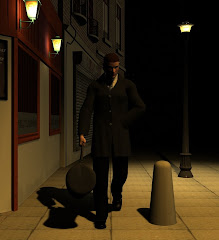
'The School of Athens' probably isn't Raphael's most famous work or even his best. But it has to be my favourite, probably because it's the most fascinating. Its visual impact is immediate. The great decorative arch which stretches from one side of the canvas to the other. Framed inside a perfect symmetry of curved ceilings which recede towards the far gateway. Pillars and statues of Greek gods lining the walls, gentle patterns of light and shade, the whole scene coloured a warm gold. Both glorious and accessible, this is Greek architecture at its most impressive.
But the surroundings never overwhelm the inhabitants. They form the most fascinating study. Raphael shows us a busy crowd scene, addictive in its variety and charming in its realism. Plato and Aristotle are entering from almost the very centre of the canvas. A line of fawners greet them. A youth seems to have been rushing up to join them before being distracted by the splendour of the building. Beside him is a bald and scantily clad man, allegedly Diogenes, lost to everything except his pamphlet. The aged Euclid teaches geometry to a party of children in the right of the foreground. His counterpart on the other side of the foreground delves into his book, seemingly trying to ignore the crowd clustering around him. There are details like this all across the painting; the two men clad in purple and gold robes collaborating on some work, the girl looking up rather resentfully at her companion leaning over her and so on. This is a diverse, energetic group united only by their love of knowledge. It is Raphael's homage to the ideals of ancient Greece.
In a way this isn't surprising. The Renaissance was a re-discovery of the classical era, a belief that ancient knowledge surpassed the contemporary forms. But The School of Athens is still an atypical painting. While Renaissance architecture, initially at least, was just straightforward copies of Greek and Roman styles, the classic influence on painting was more oblique. The likes of Raphael and Leonardo used it to perfect form, lighting and perspective. But they mainly used these techniques for the Biblical themes which dominated medieval art. The classical mindset only directly entered art through re-enactments of some legends. And the dominance of naked Goddesses of Love and rape scenes here show their real attraction for painters. Raphael was one of the view who created a vision of what he believed the long-lost age of enlightenment to be. And this wasn't the usual wistful images of fallen pillars but a vibrant, exciting reality.
Yet The School of Athens isn't simply a look back into history. Figures from Raphael's own world enter the painting. The regal Plato is actually a portrait of Leonardo. Michelangelo, meanwhile, is Heraclitus, brooding, gloomy and isolated. (A statement of how the pair were viewed in their own time; both geniuses but one a saint, the other a sociopath). Bramante, disguised as Euclid, Sodoma and Raphael himself also appear. This is not post-modernism, though that annoying phrase would be slapped onto a similar trick today, nor is it just a wave to friends. It is a manifesto. With uncharacteristic stridency, Raphael is declaring the precise aims of his artistic movement. To recreate and resurrect the wonders of this revered epoch.
And it is, for all its realism, a utopian painting. None of the severely compromised Athenian state can be seen outside. There are tiny patches of clouds and blue sky, nothing else. It may easily be a meeting in Heaven of philosophers who, after all, came from a diversity of eras. And it is easy to see the attraction for Raphael. The two chief thinkers may be entering through a small line of worshippers; and Aristotle even has the features generally ascribed to Jesus. They do not control the scene, however. Compare it with Raphael's The Disputa, an equally epic vision where every figure is precisely ordered in relation to Christ. Most of the School of Athens are ignoring the entrance of their supposed superiors. One, Zoroaster, observes with considerable scorn. And the great men themselves are only concerned with their own discussion. It is a vision of liberty. Of rigid authority replaced by the free expression of liberty. The favourite of princes and Popes, as placid as Michelangelo and Caravaggio were furious, Raphael still created one of the most subversive visions of the whole Renaissance.
